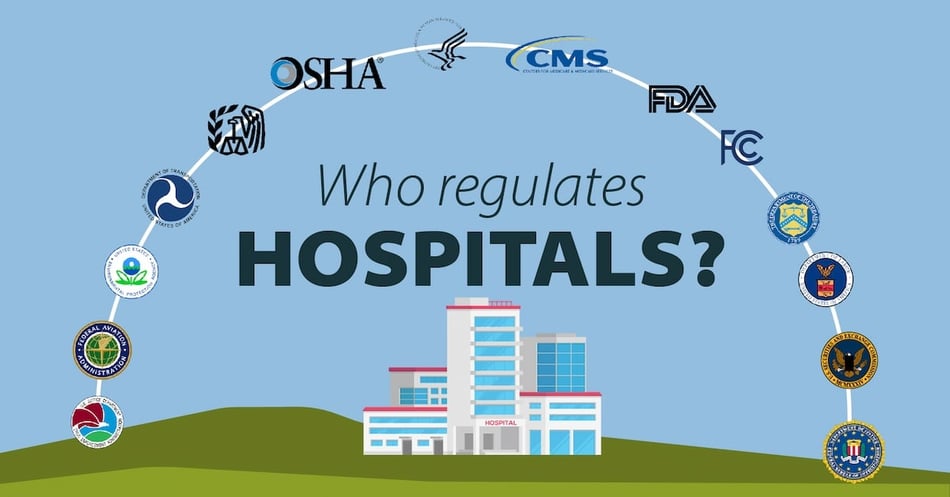Who Regulates Hospitals?

A hospital is one of the most, if not the most, regulated environments in our nation. Due to the complexity of services, equipment, usage, and upkeep, hospitals and healthcare facilities must meet the standards set by a number of federal, state, and local laws, agencies, and regulators. In today's post, we'll look at some of the more visible groups keeping hospitals safe, as well as some that may surprise you.
Let's start with the construction of a hospital. Before a hospital can even be built (in most states), it must have a Certificate of Need, a regional assessment codified into law and using data and analysis from the Department of Housing and Urban Development (HUD) that shows that the additional beds are needed in the geographic area. The building permits and construction logistics are approved by the Department of Buildings, and the design is based upon best-practices set forth by the Facility Guidelines Institute for Design and Construction (FGI) and must meet the Health Care Facilities Code and the Life Safety Code. Finally, the building must meet standards of the National Fire Protection Association (NFPA).
Now let's stock the hospital with furniture, equipment, computers, medicines, and cleaning supplies. Anything that touches a patient or enters the patient body is regulated by the Food and Drug Administration (FDA). This includes indwelling devices, pharmaceuticals, and syringes. Durable Medical Equipment contractors (DMEs) must be authorized by the Centers for Medicare and Medicaid Services (CMS), whose products are regulated bodies of their respective fields (endoscopes, beds, wheelchairs, etc.). The Drug Enforcement Administration (DEA) regulates the access shipment, storage, and distribution of controlled substances. Cleaning supplies, and any product that makes public health claims, are regulated by the Environmental Protection Agency (EPA).Telecommunications, from phone calls to mobile telemetry, is regulated by the Federal Communications Commission (FCC), which also provides remote or underserved communities with access to broadband to enable telehealth. The emergency helicopter is regulated by the Federal Aviation Administration (FAA), while the ambulances and mobile clinics are regulated by the Department of Transportation's Emergency Medical Services (DOT).
With our hospital built and stocked, now we need to hire a staff. While each medical field has its own certification process, once in the building, employees fall under several regulatory bodies. The Department of Labor ensures that every employee is paid fairly, including overtime, under the Fair Labor Standards Act. The safety of employees is regulated by the Occupational Safety & Health Administration (OSHA) and the Health & Human Services/ National Institute for Occupational Safety & Health (HHS/NIOSH).
Our hospital is now ready for patients! There are numerous regulatory bodies that monitor health procedures and treatments - too many to mention here. But overall, the hospital's patient treatment program must meet requirements set by CMS in order to receive Medicare and Medicaid reimbursement. HHS, through Quality Improvement Organizations (QIOs), operates a federal program to improve quality of care and cost effectiveness. Accreditation of the hospital can be provided by three national groups, of which The Joint Commission (JCAHO) is the most widely-known. Grants for outreach to underserved patients are regulated by the HHS' Health Resources and Service Administration. Meeting the requirements of the Organ Procurement and Transplantation Network (OPTN) allows a hospital to provide transplant surgeries. Patient feedback is collected and reported by the National Research Corporation's Consumer Assessment of Healthcare Providers and System (CAHPS).
And behind the scenes, we have the all-important administration of the hospital. Medical Administrative Contractors (MACs) are authorized by CMS to help hospitals file reimbursements. The Internal Revenue Service (IRS) provides non-profit hospitals with tax-exempt status and regulates how a hospital educates patients about their access to payment assistance. Patients are further supported by regulations from the Federal Trade Commission (FTC), which protects health consumers from unfair practices and health monopolies. Donations to charitable hospitals are regulated by the Treasury Department, which, along with the IRS, monitors patient access to financial assistance through the Affordable Care Act (ACA). In for-profit hospitals, the Securities and Exchange Commission (SEC) regulates investors as well as the markets where stocks in healthcare companies are traded. Any health care fraud, including insurance fraud, is regulated and investigated by the Federal Bureau of Investigations.
Whew. That's a quick introduction to the many regulatory bodies involved in the construction and operation of a hospital... and we probably missed some along the way. Still, it is reassuring to know that so many entities are involved in healthcare oversight and ensuring patients receive the safest and best care possible. Please let us know any we missed in the comments below, and download the infographic that captures the information in this post in a helpful graphic.
![EOScu Logo - Dark - Outlined [07182023]-01](https://blog.eoscu.com/hubfs/Eoscu_June2024/Images/EOScu%20Logo%20-%20Dark%20-%20Outlined%20%5B07182023%5D-01.svg)

![[infographic] Who Regulates Hospitals? Download and share!](https://no-cache.hubspot.com/cta/default/216314/interactive-178295792789.png)